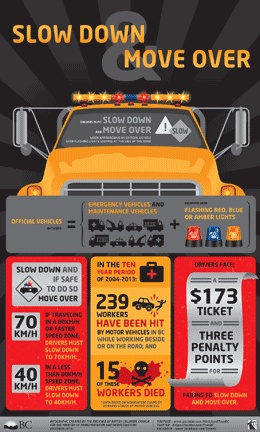Slow down to protect our roadside workers

By Todd Stone
B.C. Minister of Transportation and Infrastructure
People who work to keep us safe often do so in dangerous places. Think about working on the side of a highway with barely more than a meter between traffic and a guard rail.
This is the workplace of thousands of women and men who remove debris from travel lanes, clear culverts, repair traffic signals and hundreds of other important tasks every day - and night - on our roads and highways. They need space to do their work safely.
In the past, drivers were required to slow down and move over for official vehicles only, such as stopped police cars and ambulances with blue or red lights flashing. Others who work to keep our highways safe said that this wasn't enough.
The BC Road Builders and Heavy Construction Association, and our highway maintenance contractors, raised concerns that this did not protect all roadside workers.
We listened, and responded: As of Jan. 1, 2015, Slow Down Move Over protection is extended to all vehicles with red, blue or yellow flashing lights stopped on the side of a road - because a stopped vehicle means there are people working nearby.
The expanded Slow Down Move Over regulation requires drivers to drop their speed as soon as flashing lights are visible. On a highway, that means dropping to 70 kilometres an hour or slower. If the speed limit is 70 kilometres per hour or less, drop to 40 kilometres an hour or slower. Slowing down gives drivers more time to react in the event that more defensive action is required.
Roadside workers need a buffer from traffic, so it is also important to signal and move to the adjacent lane on a four-lane highway or road. By slowing down, signalling and moving away from roadside work, drivers are doing their part to keep workers safe, as well as being an example to other drivers to follow.
There are more than 2,000 contracted employees willing to work 24 hours a day, seven days a week to keep our highways and roads open, safe and reliable. In addition, there are hundreds more people who have reason to stop and turn on the flashing lights, including conservation officers, commercial vehicle safety enforcement officers, land surveyors, park rangers, tow truck operators, municipal maintenance workers, contracted electronic technicians and geotechnical engineers in addition to police, fire and ambulance services.
The Drive BC website lists scheduled maintenance work and any effect it may have on traffic, which helps motorists to be prepared for flaggers directing traffic around work zones.
But not all work can be planned. Inclement weather may result in result in rock or tree branches falling on roads, or an incident could damage a sign or traffic signal. Insecure loads could mean debris on travel lanes, or wildlife could be killed.
Whether planned maintenance or an unexpected event, we know one thing for sure: there are people working on the sides of our highways every day of the year.
The legislation is clear: These people are keeping roads safe for our travel. Let's keep them safe from harm by obeying the law, and slowing down and moving over.









